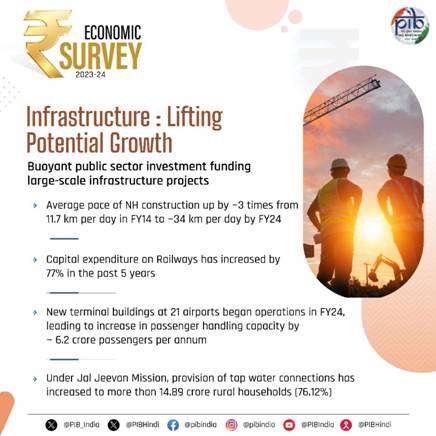
With increased public investment over the last five years, India has witnessed significant expansion in physical and digital connectivity and social infrastructure including sanitation and water supply helping to improve quality of life of the people, states the Economic Survey 2023-24 tabled by Union Minister of Finance and Corporate Affairs, Smt Nirmala Sitharaman in Parliament today. The Survey notes that the foremost among the responses initiated by the Union Government to overcome the pandemic-driven slowdown in the economy was increase in capital expenditure, aimed particularly at the creation of high quality physical and social infrastructure facilities. Keeping the momentum going over the last five years, the Survey says, capital expenditure of the Government has seen an almost three-fold increase in FY24, relative to FY20 levels. It added that the major beneficiaries of this step-up are key foundational assets like roads and railways.

ROAD INFRASTRUCTURE:
The Economic Survey observes that strategic planning and step-up in public investment have resulted in the upgradation of the road network system into a resilient and efficient infrastructure. The capital investment by the Government and private sector rose from 0.4 per cent in FY15 to about 1.0 per cent of GDP (around ₹3.01 lakh crore) in FY24. The sector has attracted its highest-ever private investment in FY24 as the private sector capitalises on a conducive policy environment, mentions the Survey.
Referring to the significant progress in the development of national highways, the Survey says that the development of national highways, over the last ten years, has increased by 1.6 times from 2014 to 2024. It states that the Bharatmala Pariyojana has significantly expanded the national highway network, increasing the length of high-speed corridors by 12 times and 4-lane roads by 2.6 times between 2014 and 2024. Further, the Survey notes that the efficiency of highway construction has improved due to the systematic push through the corridor-based National Highway development approach. The average pace of NH construction increased by 3 times from 11.7 km per day in FY14 to 34 km per day by FY24, it states. The survey observes that the remarkable improvement of the NH network has brought about substantial advancements in logistics efficiency which is evidenced by the consistently rising India’s ranking in the World Bank’s ‘Logistics Performance Index, from 54 in 2014 and 44 in 2018, to 38 in 2023.
To further enhance logistic efficiency, the Economic Survey has mentioned that the Ministry of Road Transport & Highways (MoRT&H) has dedicated Multi-Modal Logistics Parks (MMLP). It says that a total of six multimodal logistics parks (MMLPs) have been awarded until FY24, and ₹2,505 crore have been awarded for dedicated multimodal logistics parks (MMLPs) in FY24. Further, it stated, seven MMLPs are planned to be awarded in FY25.
RAILWAYS INFRASTRUCTURE
According to Economic Survey 2023-24, Indian Railways, with over 68,584 route km (as of 31st March 2024) and 12.54 lakh employees (as of 1st April 2024), is the fourth largest network in the world under single management. Survey states that the capital expenditure on Railways has increased by 77 per cent over the past 5 years (₹2.62 lakh crore in FY24) with significant investments in the construction of new lines, gauge conversion, and doubling.
The Survey notes that the Railways has achieved its highest-ever production for both locomotives and wagons in FY24. Survey states that 51 pairs of Vande Bharat have been introduced until March 2024. The fast pace of infrastructure augmentation has been the result of a substantial increase in financial allocation along with close project monitoring and regular follow-up with stakeholders for expeditious land acquisition and clearances, the Survey observes.
The Survey has also mentioned about the initiatives undertaken by Railways for providing clean environment in and around railway stations and trains, such as replacement of conventional toilets with bio-toilets on coaches leading to clean tracks, segregation of bio-degradable/non bio-degradable waste, solid waste management and discouraging use of single use plastic.
The key focus areas for Railways, according to Economic Survey 2023-24 include fast capacity augmentation, modernisation of rolling stock and maintenance, improving quality of services and energy efficiency. In line with this, the Survey states that the investments are prioritised in areas like dedicated freight corridors, high-speed rail, modern passenger services like Vande Bharat, Amrit Bharat Express, Aastha Special Trains, high-capacity rolling stock and last-mile rail linkages. Projects for three major corridors viz. (1) High-traffic density corridors, (2) Energy, Mineral and Cement Corridors and (3) Rail Sagar (port connectivity) corridors are also planned to reduce logistics cost and carbon footprint, the Survey said. As per the Survey, Railways has also planned to reduce its carbon footprint primarily through sourcing of its energy requirements through renewable energy sources and the expected requirement of installation of renewable capacity by 2029-30 is around 30 Giga Watts. Other strategies mentioned by Survey include shifting from diesel to electric traction, promotion of energy efficiency and afforestation.
*****
